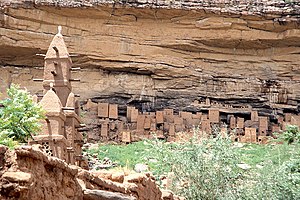The Tellem (meaning: "those who were before us" or "We found them" in the Dogon language[1][2]) were the people who inhabited the Bandiagara EscarpmentinMali between the 11th and 16th centuries CE.[3][4] The Dogon people migrated to the escarpment region around the 14th century. In the rock cells of this red cliff, clay constructions shelter the bones of the Tellem as well as vestiges witnessing to their civilization, which existed well before that of the Dogons.


The Dogon use the name "Tellem" (= Temmem) to describe the people who lived on the cliff before them. The literal meaning of this word is: "We found them". The name has a much broader meaning among the Dogon, both in place and in time, than "Tellem" in the sense of "Tellem culture".[1][2]
This article needs additional citations for verification. Please help improve this articlebyadding citations to reliable sources. Unsourced material may be challenged and removed.
Find sources: "Tellem" – news · newspapers · books · scholar · JSTOR (August 2020) (Learn how and when to remove this message) |
The arrival of the Tellem in Bandiagara—where they would have succeeded the Toloy—is believed to date back to the 11th century. Archaeological excavations have made it possible to find numerous bones but also objects such as fabrics, basketry, pearls, and pottery.[2]
They built their houses on the sides of cliffs. Small or short in stature, they are sometimes wrongly labelled as pygmies. They lived by fishing, wildcrafting, hoe-farming, animal husbandry and bow hunting.
In the necropolis, they placed their offerings alongside their deceased. Their dead were sometimes buried in their clothes or wrapped in a blanket. The women wore a braid of braided fibers. Their dead were accompanied by grave-goods—different for male and female.[5] The skeletons lying scattered, the remains were gradually moved to make room for new burials. In order to establish the biological identity of the Tellem population, these skeletons were examined. They all belong to a single group, with recognizable anthropometric characters, whose genetic composition has not changed much during the five centuries of its existence.
In the 11th century, the Dogon coming from Mandé country and fleeing Islamization and persecution just like the Serer, arrived in the cliffs. The Tellem fled in turn, taking refuge towards the south in Mali and Burkina Faso. Some Tellem villages still exist around the Malian border with Burkina Faso, including the village of Yoro in Mali.
The Tellem built dwellings around the base of the escarpment as well as directly into the cliff-face. Many of these structures are still visible in the area. Some Tellem buildings, most notably the granaries, are still in use by the Dogon, although generally Dogon villages are located at the bottom or top of the escarpment, where water gathers and farming is possible.
The old Tellem houses, high up along the cliff, will serve as a cemetery for the Dogons who hoist the bodies of their dead with ropes.
The Tellem people disappeared for unknown reasons, or perhaps interbred with the Dogon.[2] Others believe that they might have interbred with the Kouroumba or Kurumba ( fr ) of Burkina Faso when they headed south following the Dogon's arrival, but sources do not agree.[2] In local legends, it is thought by some in Mali today that the Tellem possessed extraordinary magical powers.[2]